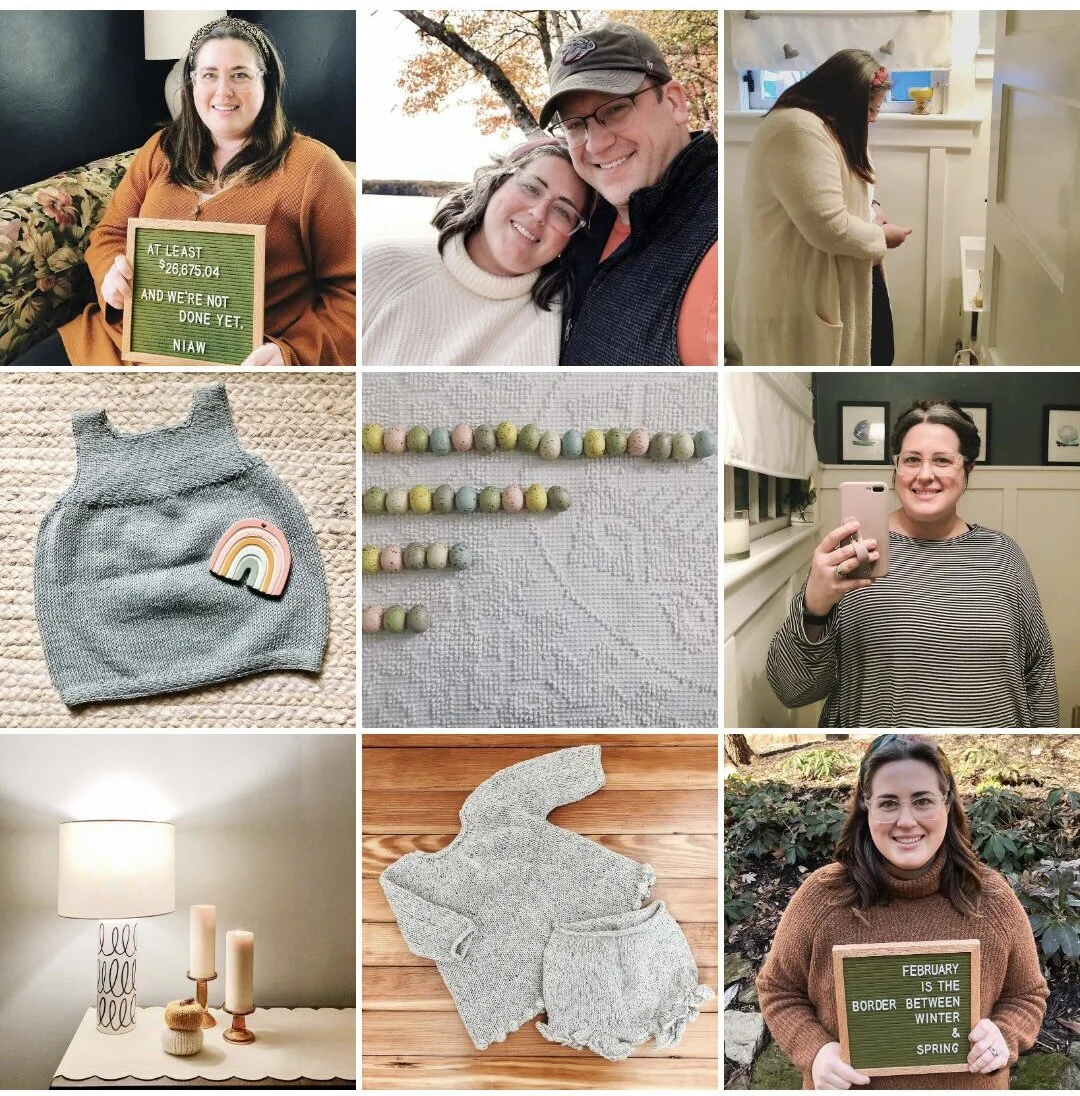Our Infertility Journey: Part Eight
/Infertility impacts approximately 15% of couples in America and is a result of abnormal functioning of the male or female reproductive systems. Because I have Polycystic Ovarian Syndrome (PCOS), I live with one of the most common causes of infertility in women.
To be clear, my goal with these posts is to be open. Since we began fertility treatments in 2017 I've done a lot of searching to find experiences and stories from women living with PCOS and/or going through fertility treatments, and so far I haven't come up with much. Because I want to hear about what other women are experiencing, I am sure that others out there feel the same. While I know this is my story, I hope that by sharing it openly I will help someone else through whatever they are experiencing.
my top nine posts on instagram in 2020 were almost all about our infertility and ivf journey!
Hello, and Happy New Year, friends! I hope it’s not too late to say Happy New Year - truthfully, I always wonder what the appropriate cut off is at the start of a new year for using that greeting…
Anyway, it’s a new year, there are new things happening in our infertility journey, and I’m ready to share an update!
If you follow me on Instagram, you know by now that at the end of the summer (after my last update post), we completed an ERA test and had our first frozen embryo transfer (FET)! The ERA test showed that I am 12 hours pre-receptive, which means that as a part of our FET prep, I need to add 12 more hours of progesterone exposure in order to ensure my uterus is ready to accept an embryo. The ERA test was completed in July and we were able to roll right into prepping for our FET after that test was completed. On August 3 we transferred our first frozen embryo and survived the two week wait to find out that it was successful! Unfortunately, our happiness was short lived - our first FET ended in miscarriage on September 30. We had almost 10 short weeks with our baby girl and were heartbroken when we learned her heart had stopped beating sometime in between my 9 and 10 week monitoring appointments.
The months of October, November, and December honestly felt like a blur at times. Now that we are out of the holiday season and into a new year, I think Kurt and I are feeling a little like the fog is lifting and we’re able to find some hope again surrounding this journey to become parents. And there are a few things that happened between October and now that I’m ready to catch you all up on!
what happened this fall
The appointment when I learned there was no longer a heartbeat was supposed to be my graduation appointment from our clinic. At our week 9 appointment the week prior, our doctor did diagnose erratic fetal cardiac activity in our little embryo, so we knew that things might not be ok. Her heartbeat dropped enough to cause concern, and that concern was clearly warranted. Unfortunately, at 9 weeks, an embryo is too small to try anything to help that heartbeat to increase, so we had to wait and see what was going to happen. The morning of our 10 week scan when I learned there was no longer any heartbeat, we were devastated. But I could feel that we weren’t alone - the nurses and doctors who had seen me and this growing embryo week after week cried alongside us too.
That morning after getting dressed from the ultrasound, Kurt and I were able to meet with one of our doctors in the office. She walked us through a couple of options, and let us decide how we wanted to proceed. I knew I didn’t want things to linger, and together Kurt and I made the decision that I would have a D&E performed in the clinic office the next day. I was given medicine that I took vaginally to help start the dilation of my cervix and the next morning we returned to the office for the D&E.
The D&E was performed while I was completely awake. My doctor had me slowly count to 10 as he suctioned out the tissues from my uterus. All I could do was hold Kurt’s hand and try not to cry too loudly. I remember vividly thinking about not wanting to cry too much because I didn’t want to scare any of the other women out in the office waiting area. Infertility causes enough tears, and I really wanted to do my part not to make anyone worry or get upset. By the time I got to around 5-6-7 in my counting, I could feel the pregnancy tissues exiting my body. I don’t think I’ll ever forget what that felt like. After the procedure, we came home and I slept for hours. My doctor called me later in the day to check in, but I was asleep so I missed his call. He left me a voicemail saying how hard he knew this experience was and how brave I was to have gone through it. I listened to that voicemail about once a week all throughout the end of 2020 to remind myself that I can do this, even though it feels really hard sometimes.
Even though the embryo we transferred was genetically normal, as a part of the D&E process, the tissues that were collected were sent off for testing to see if there were any genetic abnormalities that would have caused the miscarriage that were missed in earlier testing. Five weeks after the D&E (and lots of phone calls to our clinic asking for updates) we learned that there was nothing wrong with the embryo. Genetically, there wasn’t anything that would have caused her to stop growing.
Knowing these results, our doctor gave us the go ahead to try for another transfer if we wanted to in December. Kurt and I talked about it, but neither one of us felt ready at the time. We were struggling already in the middle of the holiday season and weren’t sure we’d be able to really feel confident about going through the steps of another FET at that point. Plus, with this being our second confirmed miscarriage, we wanted to do a bit more exploration into the cause before spending the money to transfer another embryo. So we asked if we could do a recurrent pregnancy loss panel and my doctor said yes. That bloodwork panel tested for 17 different things in me that could have contributed in some way to our miscarriages. I went for that panel the day before Thanksgiving and we received the results about another five weeks later. And again, all was normal, and nothing was wrong.
In mid-December I had an appointment to check in and see where I was in my cycle so we could start to talk about a second FET cycle at the start of 2021. After weeks of not seeing the office staff, I couldn’t believe how much I looked forward to seeing them again and feeling that wave of support at that appointment. Throughout this entire last year I have been so happy with our decision to switch to this new clinic, and it’s true still even after our loss! The support they’ve shown is incredible, and anyone reading this in the Pennsylvania / New Jersey area who is looking for fertility help, I’d recommend Dr. Glassner and Main Line Fertility without hesitation!
At that appointment in mid-December we decided that I would start birth control to start my menstrual cycle, setting us up for the possibility of a second FET in January 2021. My cycle started just a couple of days in 2021, and at this point we are about a week into our second FET protocol!
what we’re doing differently this time
Because the recurrent pregnancy loss panel came back normal, it didn’t give us any indication of things to possibly treat or adjust for in this next FET cycle. In situations like this one, my doctor likes to use a protocol he calls “the kitchen sink”. Basically, it’s a combination of medications that lowers my immune system and treats for things that are maybe unseen or difficult to diagnose that could contribute to miscarriage. So in addition to the Estradiol pills, Progesterone suppositories and Progesterone-in-Oil injections that we used for our last FET, I’ll also be adding Intralipids infusions, Prednisone pills, Lovenox injections, and Neuopogen injections. That combination has given lots of other patients at our clinic success, and we are hopeful that it does for us as well!
I started the Estradiol last week and had my first Intralipids Infusion over the weekend. At my next monitoring appointment on Monday of next week I should get my schedule for when to start the remaining medications and when I need to schedule my next Intralipids Infusion. I’ll also have a better idea of our actual transfer date!
Kurt and I are doing our best to remain cautiously optimistic right now. I am thrilled to be trying a new approach for this transfer cycle, and hope that it brings the results we are wanting. We are doing our best to focus on the things that we can control - finishing up lingering projects around the house, making sure to follow a Mediterranean diet the best we can, getting ready to go into isolation again to prevent any COVID-19 exposure and a delayed or cancelled transfer, and following my medication and supplement schedules exactly. By focusing on those things, it’s helping us to worry less about the things we can’t control. While we’re doing everything we can to make my body a suitable host for this next embryo, it’s not like we can superglue it to my uterine lining! We have to trust that my uterus and this new embryo will come together on their own and that things will all work out. It’s not easy to have that level of trust all the time, but we are certainly doing our best!
Over the next couple of weeks we would love to know our friends and family are praying for us, our medical team, and our little embryo. Feel free to drop us a note in the comments, share this post on Instagram, and text us to know we’re on your mind. Here’s to hoping that 2021 is our opportunity to become parents!















